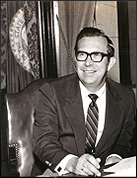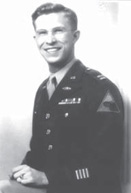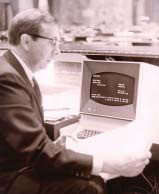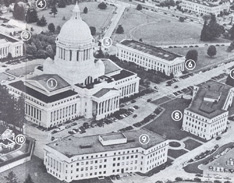Thomas L. Copeland
 Tom Copeland calls himself a conservative, but he is certainly not a traditionalist.
He was irrepressibly interested in the cutting edge in whatever business he was
engaged: changing farming practices, the processes and mechanics of operating the
Legislature, and the role and status of the Legislature as an institution. As a
very young man, Tom served in the European Theater of World War II as a tank destroyer
commander. He learned to lead men and machinery under grueling conditions, without
loss while closely engaged with enemy forces. He then brought that same energy and
drive back to Walla Walla where he expanded the family farm operations to take advantage
of new techniques, crops and markets. Tom’s deeply ingrained sense of responsibility
led him into politics, and once in the Legislature, into leadership positions. Metaphorically
speaking, Tom was still a tank commander, as he took aim at the target of reform
and planned his campaign strategy to revitalize the House Republican caucus.
Tom Copeland calls himself a conservative, but he is certainly not a traditionalist.
He was irrepressibly interested in the cutting edge in whatever business he was
engaged: changing farming practices, the processes and mechanics of operating the
Legislature, and the role and status of the Legislature as an institution. As a
very young man, Tom served in the European Theater of World War II as a tank destroyer
commander. He learned to lead men and machinery under grueling conditions, without
loss while closely engaged with enemy forces. He then brought that same energy and
drive back to Walla Walla where he expanded the family farm operations to take advantage
of new techniques, crops and markets. Tom’s deeply ingrained sense of responsibility
led him into politics, and once in the Legislature, into leadership positions. Metaphorically
speaking, Tom was still a tank commander, as he took aim at the target of reform
and planned his campaign strategy to revitalize the House Republican caucus.
Although active on several committees, Tom explains that he was chiefl y interested
in "the back room." He became immersed in tracking how the Legislature worked—and
how it could be improved. His main goal was to create a more transparent process,
so that members and more importantly, the public could understand and participate
in their government. No longer would it be acceptable for a chairman to announce
a committee meeting only minutes beforehand, with no notice to the public of what
bills were to be considered in a closed room. No longer would freshmen legislators
spend hours proofreading bills for printing errors. No longer would members keep
in touch with constituents using their own telephones and pick up the bill personally.
Tom worked to open up meetings, provide calendars and other tracking services and
create offi ce space for legislators with room for staff and other research services.
He worked closely with the State Code Reviser, Richard White, to introduce revolutionary
data processing capabilities to the legislative environment. His goal was to make
the Legislature a branch of government equal with the rapidly modernizing executive
branch.
Tom Copeland served in the Legislature during a period of great change and expansion.
The state was experiencing rapid growth and development in the postwar era. The
schools, crowded with students born during the "baby boom years," challenged systems
weakened by years of depression and neglect. As the population ballooned and new
businesses reshaped the economy, the state was hard pressed to provide new roads,
infrastructure and services. Energetic legislators like Tom Copeland grappled with
obsolete methods and brought their fresh vision and vigor to modernize the machinery
of state government. They inspired and encouraged other young men and women to win
seats in the Legislature and work for a transformation in government. Tom played
a signifi cant role in the modernization of the Legislature; his oral history is
a chronicle of reform and innovation. His legacy is embedded in what we take for
granted today: open and accessible government.
Thomas Copeland: An Oral History
Combat Commander: Photographs and Timeline of Service
 Serving in the European Theater during World War II was a particularly formative
experience for Tom Copeland. The training and habits of command he learned during
these years shaped his sense of leadership, decision-making and philosophy of life.
Tom brought these qualities to the Legislature and employed his prodigious energies
in that arena to great effect. As his wartime experiences so informed his lifelong
approach to problem solving and working as a team, a closer examination of this
part of Tom’s history is warranted. Further, so many of his future colleagues in
the Legislature had similar experiences that this study stands as a reminder of
the significance of the War for a whole generation.
Serving in the European Theater during World War II was a particularly formative
experience for Tom Copeland. The training and habits of command he learned during
these years shaped his sense of leadership, decision-making and philosophy of life.
Tom brought these qualities to the Legislature and employed his prodigious energies
in that arena to great effect. As his wartime experiences so informed his lifelong
approach to problem solving and working as a team, a closer examination of this
part of Tom’s history is warranted. Further, so many of his future colleagues in
the Legislature had similar experiences that this study stands as a reminder of
the significance of the War for a whole generation.
Modernization of Legislative Processes
 When Tom Copeland entered the Legislature in 1957 he found an institution stuck
in time, employing methods suitable to a sleepier era of government. Meanwhile,
the executive branch, under activist governors Albert Rosellini and Dan Evans, were
reforming and reorganizing state agencies and restructuring such vital functions
as the crafting of the biennial state budget, bringing in a team of expert staff
that left the Legislature lagging behind. Tom and other forward-thinking members
worked to address the increasing gap and make the Legislature a true partner in
a modern state government.
When Tom Copeland entered the Legislature in 1957 he found an institution stuck
in time, employing methods suitable to a sleepier era of government. Meanwhile,
the executive branch, under activist governors Albert Rosellini and Dan Evans, were
reforming and reorganizing state agencies and restructuring such vital functions
as the crafting of the biennial state budget, bringing in a team of expert staff
that left the Legislature lagging behind. Tom and other forward-thinking members
worked to address the increasing gap and make the Legislature a true partner in
a modern state government.
Tom Copeland focused his energies in two main areas. He analyzed the processes by
which the Legislature organized itself for its paramount duty: the passage of new
legislation. From initial research of information pertinent to bill formation to
committee functions to fi nding ways to involve the public, Tom worked to reform
every step. He served on several interim committees dedicated to this end throughout
his years of service.
His most signifi cant contribution in this area was the introduction of computers
to track information on bill progress, and capture and disseminate essential materials
throughout government. His work with Richard White, the State Code Reviser, is detailed
in a group interview conducted with Tom, Richard White and Gay Marchesini, longtime
assistant to White.
Modernization of Legislative Facilities
 The second area of concern was the physical environment provided for the legislators.
In 1957, legislators conducted all of their work at their desks in the Chambers.
When they needed to correspond with constituents and others, they called a stenographer
from a pool of office workers and dictated letters. A small switchboard took calls
and forwarded messages, but any calls the legislator needed to make were private
calls. Committee chairmen had a few more services and space, but conditions were
primitive. All of these defi ciencies were related to lack of facilities. Tom served
on the Space Allocation Interim Committee from 1965-1972, working to update services
and provide better working conditions for legislators. Creating new spaces also
allowed the legislators to employ individual assistants for the fi rst time. Concurrent
with this growing need to find space on the Capitol Campus for legislators was the
expansion of many state agencies and their subsequent need for new facilities. The
solution was to develop a new center of government buildings adjacent to the original
campus. Although complex and contested, Tom and other members worked to achieve
this transformation in facilities and design.
The second area of concern was the physical environment provided for the legislators.
In 1957, legislators conducted all of their work at their desks in the Chambers.
When they needed to correspond with constituents and others, they called a stenographer
from a pool of office workers and dictated letters. A small switchboard took calls
and forwarded messages, but any calls the legislator needed to make were private
calls. Committee chairmen had a few more services and space, but conditions were
primitive. All of these defi ciencies were related to lack of facilities. Tom served
on the Space Allocation Interim Committee from 1965-1972, working to update services
and provide better working conditions for legislators. Creating new spaces also
allowed the legislators to employ individual assistants for the fi rst time. Concurrent
with this growing need to find space on the Capitol Campus for legislators was the
expansion of many state agencies and their subsequent need for new facilities. The
solution was to develop a new center of government buildings adjacent to the original
campus. Although complex and contested, Tom and other members worked to achieve
this transformation in facilities and design.
Timeline of Capitol Campus Buildings
|
Current Name
|
Previous Names
|
Year Opened
|
|
West Campus
|
|
Governor’s Mansion
|
|
1908
|
|
Temple of Justice
|
|
1913
|
|
Insurance Building
|
|
1921
|
|
Legislative Building
|
|
1928
|
|
Irving Newhouse Building
|
Institutions, Highways, Labor and Industries
|
1934
|
|
John A. Cherberg Building
|
Public Lands-Social Security, Public Lands
|
1937
|
|
Capitol Conservatory
|
|
1939
|
|
John L. O’Brien Building
|
Public Health, Transportation, House Office Building
|
1940
|
|
General Administration Building
|
|
1956
|
|
Joel M. Pritchard Building
|
State Library
|
1959
|
|
East Campus
|
|
Capitol Court
|
|
1930
|
|
Highways-Licenses Building
|
|
1962
|
|
Employment Security Building
|
|
1961
|
|
State Archives Building
|
|
1963
|
|
Transportation Building
|
Highways, Highways Administration
|
1970
|
|
Office Building Two (OB2)
|
|
1975
|
|
Natural Resources Building
|
|
1992
|
|
Employment Security Annex
|
|
n.d.
|